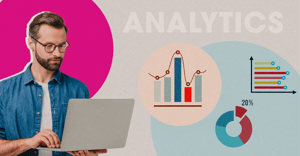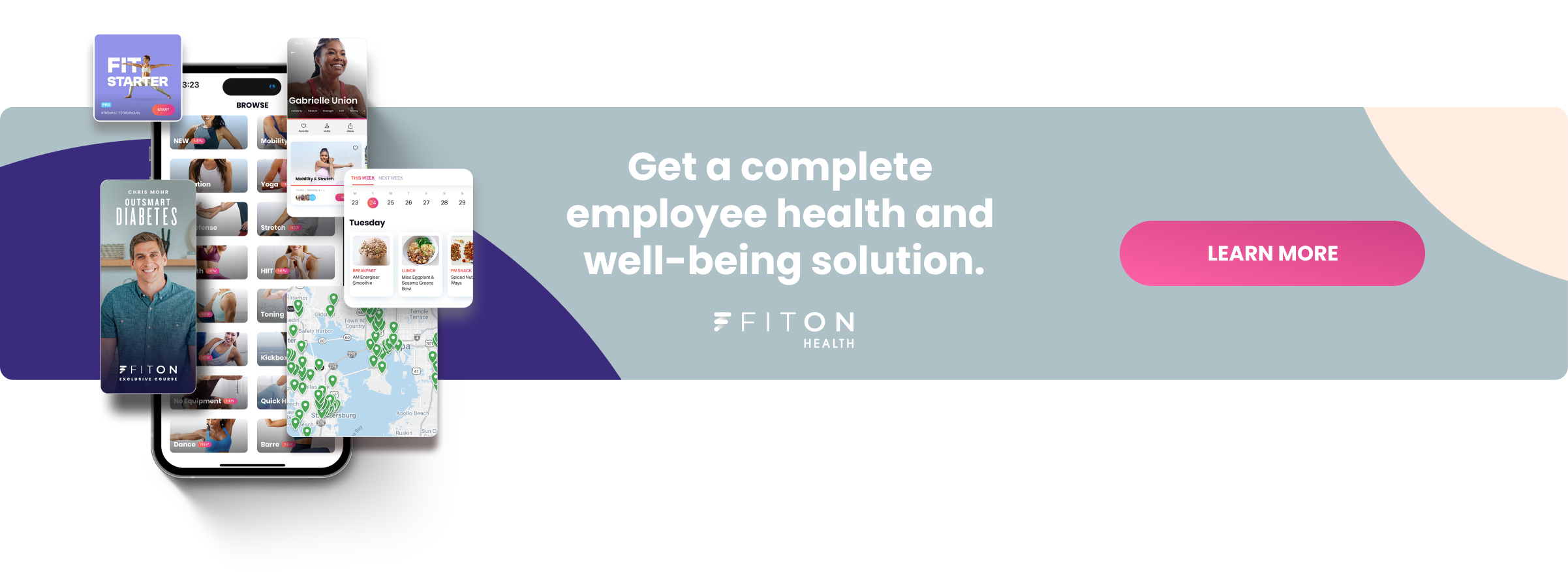Using People Analytics to Make Key Decisions
It's no secret that Benefits Managers face various challenges when leveraging data to make informed decisions about their workforce. While some may know how to use basic demographic data to make decisions about talent management, many need help leveraging data effectively regarding employee health and wellness.
A recent survey by LinkedIn revealed that 55% of HR leaders struggle with people analytics. This leaves them without the necessary insights to drive positive change. As an HR leader, you must carefully choose the right tools that provide the best analytics to help you better understand your employees.
With the increasing number of HR analytics tools available in the market, it's important to conduct thorough research and evaluate the options based on your specific needs and budget.
By analyzing this data, you can identify which programs are most effective and make informed decisions about which ones to implement. In turn, it can lead to a healthier and more engaged workforce, which is a win-win for employers and employees.
How is People Analytics Improving Workplace Relationships?
People Analytics is a fascinating practice that involves analyzing employee data and their behaviors to make informed decisions about human resource management. You may also know it as HR Analytics or Talent Analytics.
Using data science, statistical analysis, and machine learning techniques, HR professionals can draw insights from various HR-related data sets, including:
-
Employee demographics
-
Recruitment
-
Performance
-
Retention
-
Compensation and engagement
When managing your workforce, consider using people analytics to gain insights into various aspects of your workforce because it helps to:
-
Identify factors affecting employee retention
-
Predict turnover risks
-
Measure employee performance
-
Evaluate the effectiveness of training and development programs
-
Identify potential candidates for promotion or succession planning
You can leverage these insights to make data-driven decisions that improve employee engagement, retention, and overall organizational performance.
In fact, a survey by Deloitte showed that businesses that used tools to analyze their workforce's data exceeded their business goals within a year. People analytics can help businesses make better decisions about their most valuable asset – their workforce.
How Can People Analytics Transform Your Business?
HR analytics is a powerful tool that can provide an array of benefits for your business. By providing real-time data and insights into your workforce, you can make more informed decisions about managing your employees. Let's take a look at the benefits of using people analytics in your organization.
1. Increase Productivity
Using people analytics can help your organization increase productivity. It uses data analysis and statistical methods to understand and improve human resource management. Here are some of the ways using HR analytics can enhance your workforce performance and productivity:
-
Identify their top performers by analyzing employee data, such as performance metrics and engagement surveys. These employees can then be models for others to follow or be given more responsibilities and opportunities to further develop their skills.
-
Identify the characteristics and skills that make a candidate successful in a particular role. This enables the HR department to hire the right people who are more likely to be productive and stay with the organization longer.
-
Identify the factors driving engagement, such as job satisfaction, work-life balance, and recognition.
-
Recognize employee skills gaps and development needs. This allows your organization to personalize learning and development programs to meet the specific needs of each employee, resulting in improved performance and productivity.
-
Identify the optimal workforce allocation, such as the correct number of workers and their distribution across teams and projects. This strategy allows you to maximize productivity and minimize costs.
People analytics can give your organization the insights it needs to make data-driven decisions about your workforce. Businesses can use this data to inform their choices, to understand their employees and create a work environment that fosters productivity and growth.
2. Plan for Employee Retention
As an organization, retaining employees is vital for ensuring the stability and productivity of the team. You want to create an environment where employees feel valued, challenged, and satisfied.
But how can you ensure your employees are not looking for new opportunities elsewhere? This is where HR analytics can help. People analytics can help retain your workforce in the following ways:
-
Identify flight risks in your employee behavior, such as absenteeism. By identifying flight risk employees early on, you can act to retain these employees by offering promotions or professional development opportunities.
-
Forecast which employees will most likely leave the organization using predictive modeling techniques. By evaluating data on employee behavior, HR professionals can build models identifying the key factors contributing to turnover and use these models to predict which employees are at risk of leaving.
-
Analyze data from exit interviews to identify patterns and trends in why employees leave the organization. Understanding why employees leave can help you address these issues and improve workforce retention.
-
Examine data on compensation and benefits to ensure workers are paid fairly and competitively. You can improve employee satisfaction and retention by ensuring your workforce is being compensated appropriately.
Using talent analytics to plan for employee retention will allow your organization to identify potential retention issues early and take necessary steps to address them. Employee retention can help reduce turnover and associated costs, improve employee morale, and ensure the organization can retain its top talent.
3. Assess Employee Engagement
Employee engagement is crucial for creating a positive work environment, retaining top talent, and achieving better business outcomes.
People analytics can provide insights into employee engagement levels in the following ways:
-
Employee surveys: People analytics can collect and analyze data from your workforce to measure engagement levels. You can ask questions about job satisfaction, workplace culture, and employee motivation, among other topics.
-
Performance metrics: HR analytics can examine the data on performance metrics, such as productivity, attendance, and turnover rates, to measure employee engagement levels. For example, high levels of absenteeism, low productivity, and high turnover rates indicate that employees are disengaged or unhappy in their work.
-
Social network analysis: Talent analytics can use social network analysis to understand how your workforce interacts with each other and their work.
-
Sentiment analysis: People analytics can evaluate data from employee feedback, such as emails or chat logs, to gauge their sentiments. By understanding the tone and content of workers' communication, you can identify areas of dissatisfaction or disengagement.
HR analytics can assist in measuring employee engagement, identifying improvement areas, and taking action to address issues. This strategy can help your organization achieve better performance and business outcomes.
4. Helps Identify Areas to Improve Diversity and Inclusion Initiatives
Diversity and inclusion are vital considerations for organizations that want to remain competitive and successful in today's global marketplace.
According to a McKinsey study, companies with gender diversity were 15% more likely to have financial yields above their industry median. On the other hand, those with racial and ethnic diversity were 35% more likely to outperform their industry peers.
People analytics can help you identify areas of opportunity to improve diversity and inclusion initiatives in several ways, including:
-
Collecting data and analysis on employee demographics, such as gender, race, ethnicity, and age. It can help identify areas where diversity may be lacking, such as in certain departments or job roles.
-
Talent analytics can help identify potential biases in recruitment and hiring processes, such as job postings or candidate selection criteria. Unintentional biases in the recruitment process may limit your talent pool. You may end up missing out on the "right fit" for a given role. Talent analytics can help you identify patterns of success or areas for improvement in attracting diverse candidates by analyzing data on recruitment outcomes.
-
People analytics can collect and analyze data on employee engagement levels through surveys or feedback. By analyzing this data, you can identify areas where employees may feel excluded or undervalued and take targeted actions to address these issues.
-
HR analytics examines performance reviews and promotions data to identify bias or disparity patterns. Identifying these patterns helps you take steps to ensure performance evaluations are fair and equitable for all employees.
-
People analytics can evaluate employee training and development data to identify gaps in skills or opportunities for growth. By providing targeted training and development programs, HR professionals can help all employees, including those from underrepresented groups, to achieve their full potential.
People analytics can help you identify areas for improvement and take personalized actions to create a more diverse and inclusive workplace culture. This act can help attract and retain a more diverse workforce and improve overall business performance.
How to Use Data to Understand the Effectiveness of Healthcare Products
Using data to understand the effectiveness of healthcare products is crucial for HR directors, as it helps them make informed decisions about their benefits programs. One platform that can provide valuable data is FitOn Health, a fitness app allowing employees to access personalized workout plans and track their progress.
Here are some ways HR leaders can use data from FitOn Health to understand the effectiveness of their healthcare benefits program:
-
Identify Trends: HR directors should identify trends in the data that may indicate whether the product is effective or not. For example, if employee engagement increases or the cost of healthcare benefits decreases after employees start using the app, this could indicate that the product is effective.
-
Better predict health outcomes: HR directors can use data from FitOn Health to track employee health outcomes such as weight loss, improved cardiovascular health, and reduced stress levels. This information can help them understand the impact of their healthcare benefits program on employee health and wellness.
-
Improve cost savings: HR directors can use data from FitOn Health to track healthcare costs and identify potential cost savings. For example, if employees who use FitOn Health have lower healthcare costs than those who do not, this can indicate the app is helping to improve employee health outcomes and reduce healthcare spending.
-
Develop program improvements: Based on data analysis of app engagements, benefits managers can make informed decisions about their healthcare benefits. They can decide whether to continue offering the same package or make improvements to the existing program based on the data collected. For example, if there was an uptick in employees engaging with a course on heart health, they could add a new tier to their healthcare benefits that emphasizes care in critical illness.
FitOn Health Can Help Your Business Make Smarter HR Decisions
FitOn Health is a mobile fitness and wellness app that provides users access to various workout classes, programs, and personalized coaching. The app also includes a range of wellness resources, including nutrition and meditation content.
As an HR leader, you can use FitOn Health's data to gain deeper insights into your organization's workforce. Schedule a demo today to learn more about FitOn Health and how it can help you improve workforce management.
Never miss a beat


